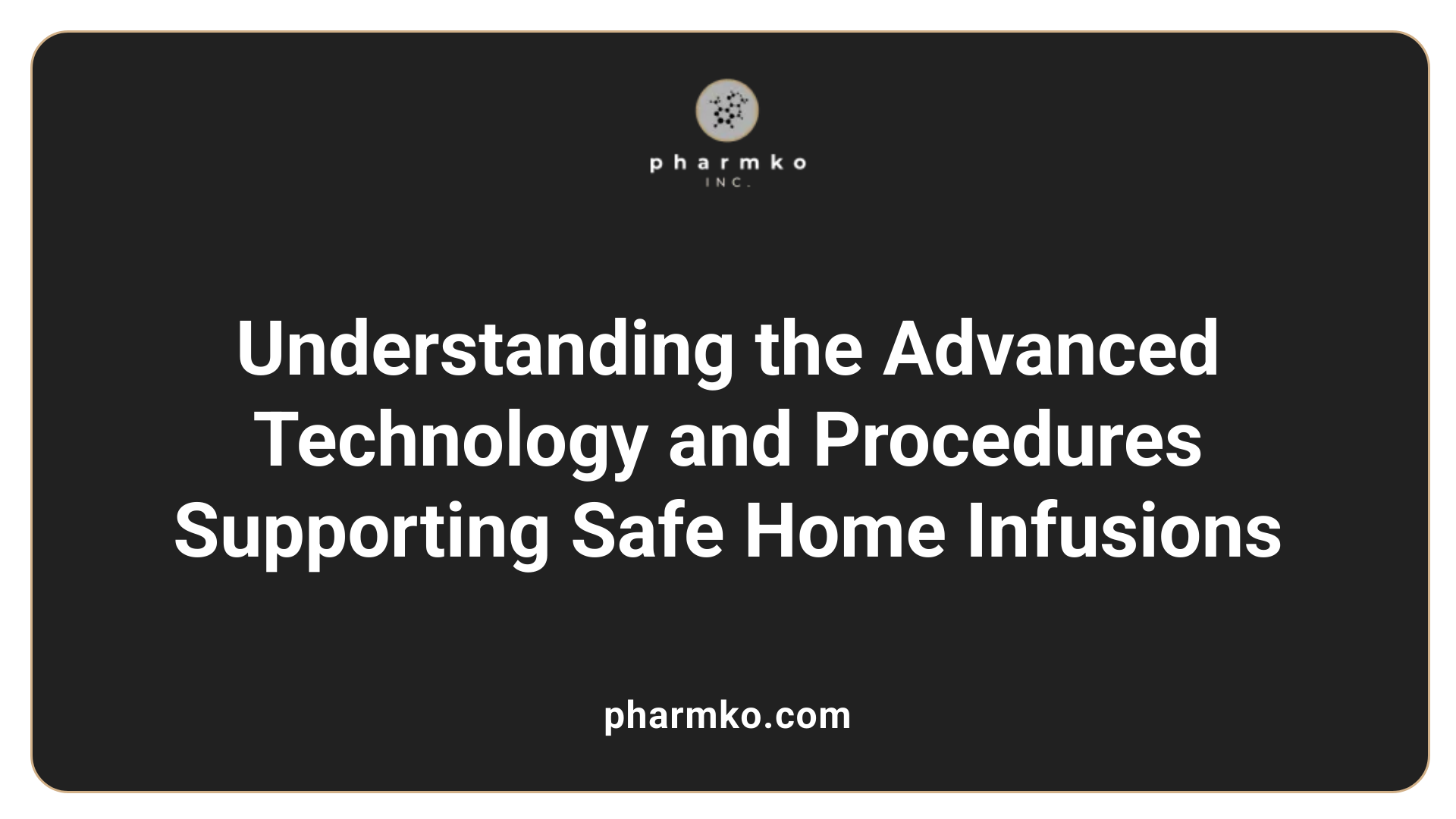Home infusion for improved outcomes
Revolutionizing Healthcare Delivery in the Comfort of Home
Home infusion therapy is rapidly emerging as a safe, effective, and patient-centered alternative to traditional hospital-based treatments. By enabling the delivery of essential medical therapies directly into patients’ homes, this approach enhances health outcomes, boosts patient satisfaction, and offers significant cost savings. Driven by advancements in technology, clinical evidence, and expanding insurance coverage, home infusion therapy is transforming the landscape of modern healthcare, particularly for patients with chronic or complex conditions.
Understanding Home Infusion Therapy and Its Impact on Health Outcomes

What is home infusion therapy and how does it improve health outcomes?
Home infusion therapy is a method of administering medications directly into a patient’s bloodstream or tissues in their own home, rather than in a hospital or clinic setting. It includes the delivery of treatments such as antibiotics, antivirals, chemotherapy, pain management, hydration, and nutritional support like parenteral nutrition.
Supported by specially trained infusion nurses and working in coordination with licensed pharmacies, home infusion involves the use of various devices including portable pumps and vascular access devices like PICCs or ports. These sophisticated tools ensure safe, accurate, and efficient delivery of medication tailored to each patient’s needs.
This approach offers several benefits that enhance health outcomes. By allowing patients to receive treatment at home, it reduces hospital stays and associated risks such as infections. The personalized care plans and continuous monitoring provided by healthcare professionals enable prompt adjustments to therapy based on patient responses.
Patients often report higher satisfaction, experiencing greater comfort and less stress. This increased comfort and convenience promote better adherence to medication schedules, leading to more effective management of chronic and acute conditions. Moreover, home infusion therapy has been shown to produce health results that are as good as—or sometimes better than—traditional hospital infusions, including notable reductions in hospitalization for complications like bleeding in hemophilia patients.
Cost savings are another significant advantage. Studies demonstrate that home infusion can save between $1928 and $2974 per treatment course, mainly by avoiding inpatient hospital costs and reducing resource utilization.
Overall, home infusion therapy combines safety, efficiency, and patient-centered care, making it a valuable alternative for suitable patients with complex medical needs.
Benefits of Home Infusion: Safety, Effectiveness, and Cost-efficiency
 Home infusion therapy offers numerous advantages that make it an increasingly popular healthcare option. One of its foremost benefits is safety; studies show that adverse drug events and side effects are not more common in home settings compared to hospitals or outpatient clinics. In fact, the risk of hospital-acquired infections tends to be lower, which is especially crucial for immunocompromised patients.
Home infusion therapy offers numerous advantages that make it an increasingly popular healthcare option. One of its foremost benefits is safety; studies show that adverse drug events and side effects are not more common in home settings compared to hospitals or outpatient clinics. In fact, the risk of hospital-acquired infections tends to be lower, which is especially crucial for immunocompromised patients.
Clinical outcomes for patients receiving infusions at home are at least as good as, and often better than, those treated in medical facilities. For example, patients with hemophilia experience about a 40% reduction in hospitalization rates for bleeding complications when treated at home, highlighting the therapy’s effectiveness.
Patient satisfaction and quality of life significantly improve with home infusion. Patients enjoy greater independence, comfort, and the familiarity of their own environment. They also experience fewer disruptions to personal and family life, contributing to better mental and emotional well-being.
Economically, home infusion provides substantial cost savings. Treatment courses administered at home typically cost between $1,928 and $2,974 less than comparable hospital-based infusions. These savings arise from reduced inpatient stays, decreased resource utilization, and lower transportation and facility charges. On a broader scale, studies estimate potential Medicare savings of nearly $3 billion over five years if more patients transitioned to home infusion.
Additionally, home infusion’s personalized approach enhances adherence and overall satisfaction. Patients receive tailored care plans, regular monitoring, and support from skilled healthcare professionals, which collectively improves health outcomes.
In summary, home infusion therapy is a safe, effective, and cost-efficient treatment option that benefits patients, healthcare providers, and payers alike. Its combination of safety, improved outcomes, and economic advantages positions it as a valuable alternative to traditional hospital-based treatments.
| Aspect | Benefits | Additional Details |
|---|---|---|
| Safety | No increase in adverse events; lower infection risk | Lower hospital-acquired infection rates than clinics |
| Clinical Outcomes | Equal or improved results in various conditions | 40% reduction in hospitalizations for hemophilia labs |
| Patient Satisfaction | Better comfort, independence, and emotional support | Patients report higher satisfaction and adherence |
| Cost Savings | Approximately $1,928 - $2,974 saved per course | Significant reduction in healthcare system expenses |
| Overall Impact | Improved health outcomes and quality of life | Reduced hospital stays and resource utilization |
This integration of safety, clinical efficacy, patient experience, and cost-efficiency underscores the value of home infusion as a preferred healthcare approach for suitable patients.
Conditions Treated and Therapies Delivered at Home

What conditions can be treated with home infusion therapy and what types of therapies are delivered at home?
Home infusion therapy is a versatile and expanding healthcare option that allows patients to receive complex treatments directly in their homes. It is suitable for managing a variety of serious and chronic health conditions. Among the most common are serious infections such as cellulitis, sepsis, osteomyelitis, and pneumonia, which traditionally required prolonged hospital stays but can now be effectively treated at home.
In addition, home infusion therapy supports the management of chronic illnesses like Crohn’s disease, rheumatoid arthritis, multiple sclerosis, and immune deficiencies. Cancer patients often receive chemotherapy, immunotherapy, or supportive care medications through home infusion. Patients requiring nutritional support, such as total parenteral nutrition (TPN), also benefit from these services.
The therapies delivered encompass a broad array of treatments designed to improve health outcomes and patient quality of life. These include IV antibiotics, antifungal medications, antivirals, pain management drugs, hydration solutions, and specialized nutritional support like parenteral nutrition.
Delivery methods and devices used in home infusion are diverse, tailored to each treatment’s needs. Skilled healthcare professionals, including licensed nurses and pharmacists, coordinate and administer these therapies to ensure safety and efficacy. They provide comprehensive patient education to promote proper device use and monitoring for adverse reactions.
Infusion devices range from simple gravity-driven systems to advanced portable pumps, such as elastomeric pumps, ambulatory infusion pumps, and stationary pumps. These devices allow for flexible administration schedules, supporting therapy regimens that vary in duration and intensity.
Overall, home infusion therapy offers a patient-centered, safe, and effective alternative to hospital treatments, especially for patients requiring long-term, complex, or ongoing infusions. Its growing popularity stems from the convenience, comfort, and personalized care it provides, helping patients maintain their routines while managing their health condition outside of traditional medical settings.
Technological and Procedural Foundations of Home Infusion
 Home infusion therapy relies on advanced technology and strict procedures to ensure safe and effective treatment carried out in the comfort of patients' homes.
Home infusion therapy relies on advanced technology and strict procedures to ensure safe and effective treatment carried out in the comfort of patients' homes.
A cornerstone of this care are specialized infusion equipment such as programmable infusion pumps. These devices often feature smart technology, including alarms and drug libraries, to alert users about issues like occlusion, air bubbles, or dislodgement. Portable pumps, elastomeric devices, and ambulatory pumps allow flexible drug delivery modes, tailored to different therapies and patient needs.
In addition to pumps, essential supplies include sterile tubing, catheters, and vascular access devices like PICC lines and ports. The selection of vascular access depends on factors such as therapy duration, medication properties, and patient preference.
Procedural safeguards are equally vital. Licensed infusion pharmacies perform sterile compounding and maintain strict aseptic techniques during medication preparation to prevent contamination.
During therapy, healthcare professionals, including nurses and pharmacists, deliver comprehensive patient and caregiver education. Training covers proper device operation, infection prevention measures, and recognition of adverse effects. Proper catheter care and sterile techniques during administration reduce the risk of infections, particularly bloodstream infections.
Technological integration enhances safety. Remote monitoring systems provide real-time data on device functioning and patient health, alerting care teams to potential issues without delay. These systems facilitate ongoing oversight, improve adherence, and support prompt interventions if complications arise.
Care coordination among multidisciplinary teams—comprising physicians, pharmacists, nurses, and home health agencies—is fundamental for planning, implementing, and monitoring therapy. Establishing clear communication pathways ensures adherence to safety standards and regulatory requirements.
In conclusion, the backbone of home infusion comprises sophisticated infusion devices, sterile procedural practices, patient-centered education, and technology-driven safety features. These elements work together to support high-quality, safe, and effective home-based treatments.
Implementation and Operational Considerations for Health Systems
What are the key implementation considerations and operational benefits for health systems providing home infusion?
Integrating home infusion services into health systems requires careful planning and strategic preparation. First, health systems need to conduct comprehensive assessments of their organizational capabilities and infrastructure needs. This involves understanding existing resources, stakeholder engagement, and selecting technology solutions that ensure seamless interoperability with electronic health records (EHR) and other clinical systems.
A crucial component is infrastructure development. This includes establishing reliable network systems, secure data management, and access to high-quality medical devices such as infusion pumps and monitoring tools. Investing in these technologies enhances safety and efficiency, enabling remote monitoring and real-time data sharing.
Staff training and competency are paramount. Nurses, pharmacists, and care coordinators should receive specialized training on infusion technology, safety protocols, patient education, and emergency response procedures. Continuous education ensures staff remain updated on best practices, reducing errors and increasing confidence in delivering complex therapies at home.
Care coordination plays a vital role. This involves establishing clear communication channels among healthcare providers, patients, and caregivers. Advanced care management technology facilitates scheduling, medication management, and monitoring, creating a cohesive care experience. Digital tools like bedside devices linked with EHR systems improve accuracy and safety.
Evaluation and sustainability strategies should be integrated into the program from the start. Regular performance assessments, including patient outcomes, safety indicators, and cost analyses, help identify areas for improvement. Long-term planning involves system maintenance, scalability options for increasing patient load, and ongoing funding sources.
Early focus on factors like program acceptability, fidelity, and feasibility ensures the service aligns with organizational goals and patient needs. Scalability and sustainability are achieved by building adaptable workflows, training models, and infrastructure that can grow with demand.
Overall, health systems that adopt a systematic, technology-enabled, and patient-centered approach can successfully implement home infusion services. This results in enhanced patient outcomes, operational efficiencies, and significant cost savings, making home infusion a valuable component of modern healthcare delivery.
Advancing Healthcare with a Patient-Centered Approach
The growth of home infusion therapy underscores its role as a vital component in modern, patient-centered healthcare. Supported by technological innovations, evidence-based practices, and favorable economic considerations, home infusion delivers safe, effective, and convenient treatment options. By reducing hospital stays, lowering infection risks, and enhancing the patient experience, home infusion not only improves clinical outcomes but also aligns with overarching health system goals for quality, efficiency, and patient satisfaction. As the industry continues to evolve, ongoing research, policy support, and technological development will further strengthen home infusion's capacity to revolutionize healthcare delivery.
References
- Home infusion: Safe, clinically effective, patient preferred, and cost ...
- Total Care Home Infusions for Patients | Improve Quality of Life
- Home infusion therapy | Home care providers | NHIA
- A Primer on Home Infusion Administration Methods - PMC
- Home Infusion Therapy: Understanding Benefits, Challenges, and ...
- Fairview Home Infusion Outcomes
- Infusing Safety: Comparing Oncology Infusion Outcomes at Home ...
- Home Infusion Safety | Pharmacy - RWJBarnabas Health
- Best Home Infusion Providers | Safe & Effective IV Therapy
- Home Infusion: Benefits And Barriers - CareCentrix













